Refining the Work
When Frank Bliss of American Publishing Company issued Sketches,
New and Old in the 1899 uniform edition, Clemens had an opportunity
to revise and refine his work. However, the extent of his participation
in the project was limited to marking up a copy of the old index indicating
"Dates of WRITING -- & usually of publicat[ion] to the best of
my recollection ... I think that the things whose dates I have forgotten
were mainly squibs which I put into a 'Department' in the Galaxy
magazine in 1869-70 -- or possibly it was '70-'71" (Branch and Hirst,
p. 652). Bliss utilized the dates Clemens had provided as footnotes on the
first page of a number of the sketches. A number of the dates Clemens provided
were simply wrong and Bliss apparently never checked to verify them. For
example, "A True Story" was published in Atlantic Monthly,
November 1874. The date of 1876 which appears in the lower right corner
of the page from the 1899 uniform edition of Sketches, New and Old
is an error by Clemens himself.
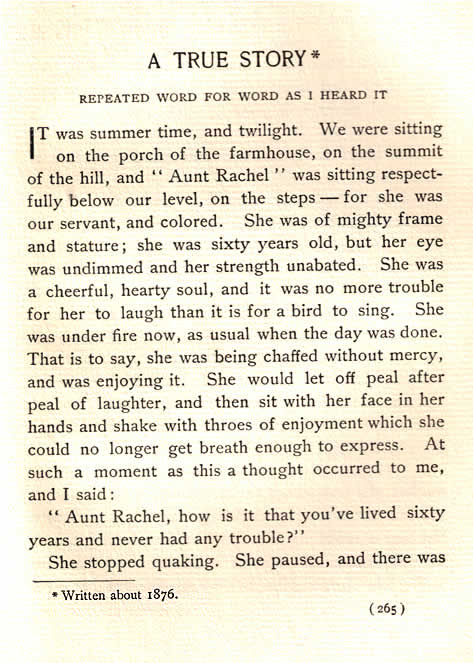
Page from
1899 edition of Sketches, New and Old showing date error of 1876.
Bliss eliminated one sketch titled "The 'Blind Letter'
Department, London P.O." from the 1899 uniform edition, probably because
it consisted mainly of illustrations. Thus the number of sketches in the
1899 uniform edition totals 62.
Production of the new 1899 plates also had the potential to
introduce inconsistencies into the texts that were the result of typesetting
errors.
|
Frank Bliss intended to correct any errors for subsequent printings
and hired Forrest Morgan (b. 1852 - d. 1924), a fastidious proofreader,
to weed out errors. Morgan, a former editor of the Hartford Travelers
Record and later an assistant librarian at Watkinson Library in
Hartford, read from a set of the Royal
Edition to mark errors.
Clemens was familiar with the work of Forrest Morgan in Travelers
Record. When Clemens wrote "Stirring Times in Austria"
in 1897 he quoted from a long passage he credited to Morgan to describe
the history of disunity in the Austro-Hungarian empire. "Stirring
Times in Austria" was published in Harper's Monthly in
March 1898 and is reprinted in Volume 22.
Morgan's 22-volume set of the Royal Edition with his annotations
is in the Beinecke Rare Book and Manuscript Library at Yale University,
a gift from William Lyon Phelps in 1922.
|
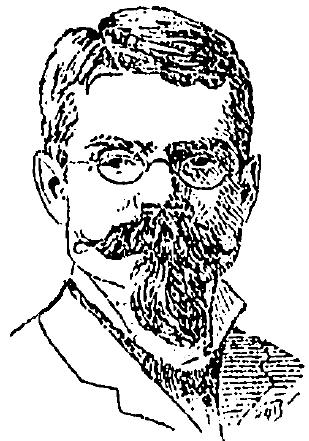
Forrest
Morgan, proofreader for the 1899 uniform edition, helped refine the
works for subsequent editions. |
Evidence suggests Morgan corrected some of the texts and compared some
of them with the original Galaxy printings. However, the original
text of Sketches, New and Old remained virtually unchanged throughout
Clemens's lifetime.
Different Titles on the Spines
Frank Bliss planned at least three volumes of Mark Twain's
sketches with Volume 19, Sketches, New and Old, being the first.
However, instead of using the book's title on the spine of the volume, Bliss
instead chose to identify the book as Volume XIX / Short Stories and
Sketches I. This designation appears in all the uniform editions published
by American Publishing Company including Autograph
Edition, Edition De Luxe,
Japan Edition, Author's
De Luxe Edition, Royal
Edition, Underwood Edition, Riverdale
Edition and Hillcrest
Edition. However, with the Harper
Author's National Editions of 1909, the title appearing on the spine
of Volume 19 was changed to match the title of the work and perhaps reduce
confusion.
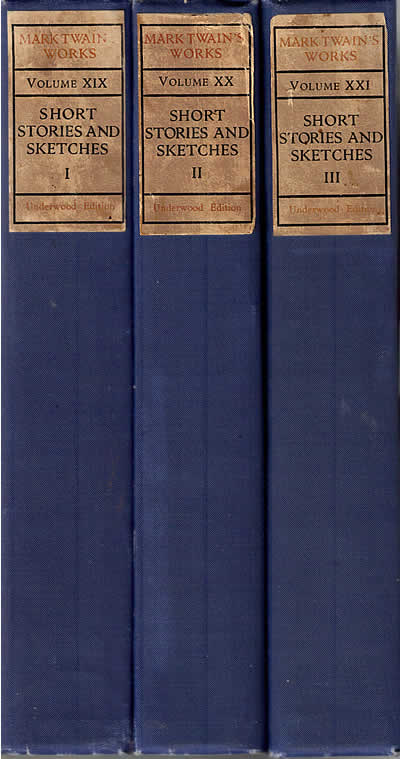
Spines
for Volumes 19, 20, and 21 from Underwood Edition identifying the volumes
only as Short Stories and Sketches |

Harper's
editions of Volume 19 list the title of the work on the spine |
W. H. W. Bicknell's Contributions
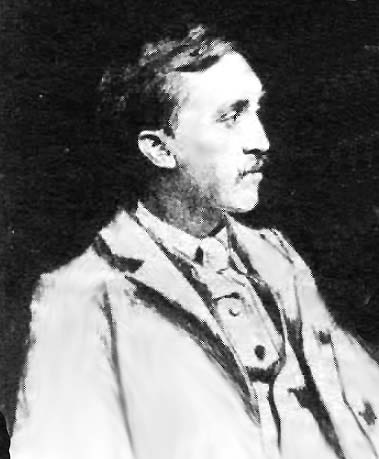
William
Harry Warren Bicknell
photo courtesy of the Winchester, Massachusetts Archival Center |
Frank Bliss hired new illustrators for the 1899 uniform edition.
Artist and etcher William Harry Warren Bicknell (b. 1860 - d. 1947)
was born in Boston, Massachusetts, the son of a grocer. Bicknell graduated
from the Boston Latin School in 1878 and later studied at the Boston
Museum of Fine Arts. He was a pupil of Otto Grundmann and Frederic
Crowningshield. Bicknell etched a number of frontispieces made from
photographs of Clemens that were used throughout the set. Bicknell's
etching of the Tiffany monogram appears as a title page in every volume
of the Autograph Edition,
Edition De Luxe, Japan
Edition, Author's
De Luxe Edition, and the Royal
Edition. All of these editions began issuing in 1899.
Less expensive editions such as Underwood,
Riverdale, and
Hillcrest feature the Tiffany title
page in Volume 1 only. It was eliminated altogether from the Author's
National Edition.
|
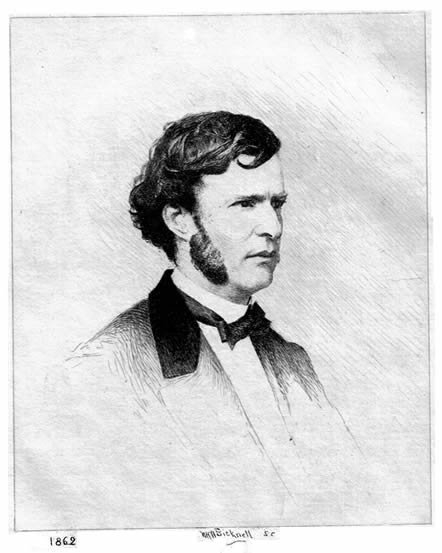
Frontispiece
of Volume 19 etched by William Harry Warren Bicknell based on a photograph
from 1862.
Frederick Burr Opper, Illustrator
|
Frederick Burr Opper (b. 1857 - d. 1937) was born in Madison, Ohio.
His father Lewis was an Austrian immigrant and his uncle Adolph Opper
was known as "De Blowitz," a Paris correspondent of The
Times of London in the 1880s.
Opper attended public schools in Madison, Ohio and at age fourteen
began work as a printer's devil at the local Madison Gazette
newspaper. Some of his earliest humorous drawings appeared in the
magazines Wild Oats, St. Nicholas, Scribner's
and Century. Opper moved to New York and studied briefly at
Cooper Union and also for short time was a pupil of Frank Beard, older
brother of Daniel Carter Beard. At age twenty he was employed on the
staff of Frank Leslie's publications where he worked for three years.
In February 1880 he joined the staff of Puck and remained with
that publication until May 1899. He was hired away from Puck
by William Randolph Hearst to draw political cartoons and comic strips
for Hearst's New York Journal and remained with Hearst's newspaper
for the next 33 years becoming one of America's most popular and wealthiest
political cartoonists.
Opper contributed six full-page illustrations to the 1899 uniform
edition of Sketches, New and Old. A receipt from Opper to American
Publishing Company survives in archives at the University
of Virginia Library, Special Collections indicating that Opper
was paid $360 on February 8, 1899 for his six illustrations.
|
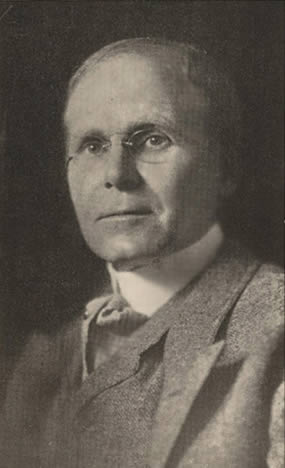
Frederick
Burr Opper |
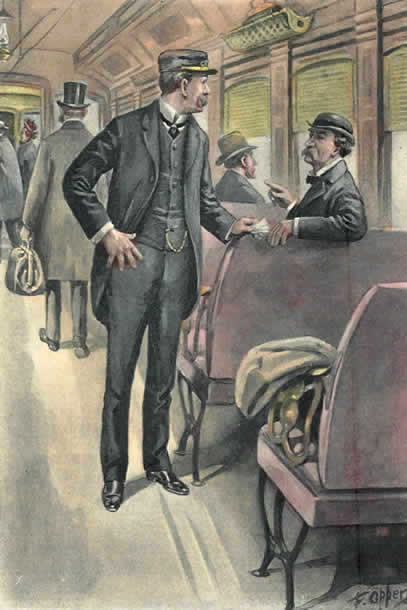
Opper's illustration
titled "Who Is That Man?" from "Cannibalism in the Cars"
featuring Mark Twain
was hand-colored and used as the frontispiece for the 1901 Riverdale
Edition.
Opper's name appears in Clemens's Stormfield Guest Book for
September 20, 1908, a few days after burglars invaded Clemens's mansion
in Redding, Connecticut. No further details of Opper's visit with Clemens
have been found. However, newspapers across the country were publishing
cartoons related to the burglary and although none by Opper have been found,
it is possible he may have visited with that purpose in mind.
References
Blanck,
Jacob, compiler. Bibliography of American Literature, Volume Two. (Yale
University Press, 1957).
Branch,
Edgar Marquess Branch and Robert H. Hirst, eds. The Works of Mark Twain:
Early Tales & Sketches, Volume 1: 1851-1864. (University of California
Press, 1979).
Duff,
O. S. "Frederick Burr Opper, Most Humorous Cartoonist of the Day,"
Common Sense, Volume 9, January 1909, p. 11. Online
via google books.
Flower,
Benjamin Orange. "Frederick Opper: A Cartoonist of Democracy," The
Arena, Volume 33, June 1905, pp. 583 - 593. Online
via google books.
"Frederick
Opper, Comic Strip Artist," The New York Times, 28 August 1937,
p. 15.
Mark
Twain Project online database of letters from the Mark Twain Papers/Project
at the University of California at Berkeley.
Rasmussen,
R. Kent. Critical
Companion to Mark Twain, Volumes I and II. (Facts on File, 2007).
Twain,
Mark. Sketches, New and Old. Japan Edition. (American Publishing Company,
1899).
_____.
Sketches, New and Old. (Oxford University Press, 1996).
West,
Richard Samuel. Satire on Stone: The Political Cartoons of Joseph Keppler.
(University of Illinois Press, 1988).









